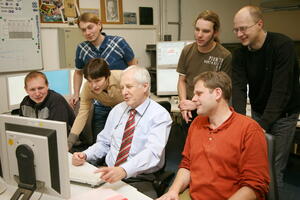How Fritz Wagner "discovered" the H-Mode
Fusion science has been a matter of progressive understanding, painstaking work and patient but continuous progress. Once the fundamentals of magnetic confinement had been established in the early 1950s and the tokamak became the dominant concept in the 1970s, major advances were made but few actual "discoveries."
One of these momentous events, probably one of the most important in the history of fusion research, occurred on 4 February 1982. Experimenting on the ASDEX tokamak at the Max Planck Institute for Plasma Physics (IPP) in Garching, Germany, the German scientist Fritz Wagner was confronted by a totally unexpected "transition" in the neutral beam heating experiment he was conducting. "It came out of nothing," recalled the recently retired 65-year old physicist during a visit to ITER. "It wasn't predicted, it just happened..."
What was soon to be known as the "H-mode" (H for High) appeared first as "a strong and sudden change in plasma characteristics." As the plasma in ASDEX was exposed to intense heating by the neutral beam, its confinement suddenly improved by a factor of two and the turbulences at the plasma edge all but disappeared.
This discovery was highly important for mastering fusion power at an industrial scale. But was it too good to be true? "A new type of instabilities, which were later called Edge Localized Mode or ELMs, had appeared along with the high confinement. At first glance, some of the senior people in the lab confused them with an effect of the core instability that was familiar to them—the so-called 'saw-teeth,' and consequently they didn't think much of it. But I was fairly new to fusion and without much experience, I found it extremely exciting. I spent a whole weekend analyzing the data. On the following Monday it was clear: the 'high confinement' was for real."
It took some time, though, for the "H-Mode" to be accepted internationally. Fritz Wagner remembers an international conference in Baltimore, soon after that fateful February, where he "was grilled for hours" by his colleagues during an evening session. Key to scientific acceptance was being able to reproduce the circumstances which had lead to H-mode ... and this wasn't easy at the beginning. But soon, says Wagner, "we were able to get H-mode whenever we wanted it. Now once in a while we'd like not to have it, but it's difficult to get rid of..."
In the following years, H-mode was observed in the American machines PDX and DIII-D, the Joint European Torus (JET) and the Japanese JT-60, then on several other tokamaks. In 1993, H-mode was also achieved in the German W7-AS stellarator, thus demonstrating it was a "generic feature" of all toroidal configurations.
A quarter century after its discovery, the understanding of the physics behind the H-mode "is still incomplete." But its value is unquestioned: H-mode is what "makes the goals of fusion possible." All tokamaks today are designed to operate in H-Mode and without it, ITER would have needed to be twice as large and, consequently, twice as expensive.
In a 2007 paper, reflecting on "A quarter-century of H-mode studies" and the circumstances of H-mode discovery, Fritz Wagner wrote, quoting Nietzsche: "The essence of any discovery is in the coincidence, but most people never encounter this coincidence."(1)
(1) "Das Wesentliche an jeder Erfindung tut der Zufall, aber den meisten Menschen begegnet dieser Zufall nicht."


